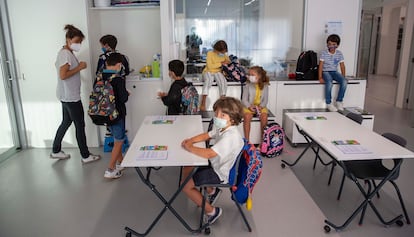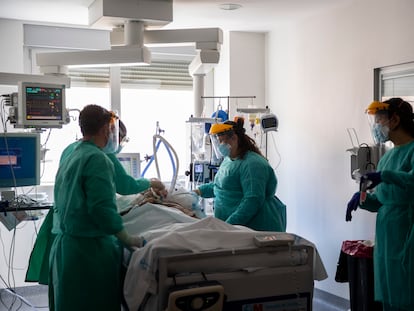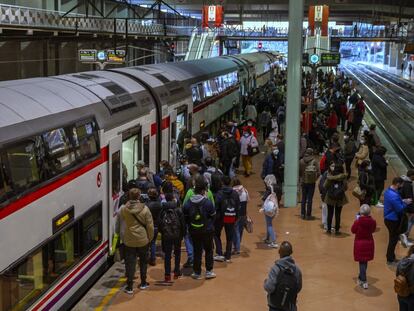Early study in Spain shows school reopenings have not led to increased coronavirus spread
A preliminary analysis for the EU by a research group at the Polytechnic University of Catalonia suggests that safety measures may be preventing significant transmission among students

A report by a team from the Polytechnic University of Catalonia (UPC) has concluded that the first weeks of the new school year in Spain have not had a significant impact on the evolution of the coronavirus epidemic.
“If schools had acted as amplifiers of contagion, we should already observe an effect on the global incidence,” reads the analysis by the Research Group on Computational Biology and Complex Systems at the UPC’s physics department, which has sent its findings to the European Commission.
The academic year at primary and secondary schools began between September 7 and 14, depending on the region. In order to determine whether coronavirus transmission inside schools has been notable since then, researchers focused their analysis on specific regions that publish data series disaggregated by age: Andalusia, Castilla y León, Catalonia and the Valencia region, plus Madrid because of its relevance as the epicenter of the epidemic in Spain.
“It’s important to underscore that this is just a first analysis and that everything can change. But what we are seeing is that school reopenings in themselves have not significantly altered the trends,” says the physicist Clara Prats, who participated in the study. “The regions where incidence was already rising continued to experience a rise at a similar rate, and those where it was going down continued to see a decline.
“It’s possible that there is a more subtle change underway that we will notice in the coming weeks, but this is the picture for now,” she adds.
These results seem to confirm the usefulness of the measures adopted by schools to prevent transmission, including the creation of stable groups of students – called “bubbles” – and the obligation to wear facemasks among students over the age of six.
But the results must be viewed with caution because they focus on a short period of time, and also because of the good weather that has so far made it easier to ventilate classrooms, admits Prats.
Analysis by age
The study – part of a larger report called “Analysis and prediction of Covid-19 for EU-EFTA-UK and other countries,” – looked at the 14-day cumulative number of coronavirus cases per 100,000 inhabitants in Spain at the time that schools reopened, then checked the incidence again three weeks later. It also analyzed the evolution of transmission in individuals up to 18 years of age in four regions of Spain that provide figures disaggregated by age.
These figures show that Andalusia and Catalonia experienced a slight increase in contagion among the school-age population. But this could be explained by greater screening efforts, note the researchers. In Catalonia, for instance, every time a child tests positive for the coronavirus, PCR tests are conducted on all other children in the same “bubble group.” There have also been mass screenings at schools located in high-incidence zones.
In Andalusia, which has just announced a protocol change, tests have so far only been conducted on classmates considered to be “close contacts,” which sometimes means the entire class and sometimes only a few students. But when more tests are done in a population group with many asymptomatic individuals, it is to be expected that the number of positive cases will grow, as well as its relative weight compared with other population groups that are not undergoing so much screening.
Ups and downs
In the Valencia region, which tests all members of a bubble group when a positive case is detected, the data shows a slight decrease in transmission among students since schools reopened. In Castilla y León, however, there has been a relevant increase among children up to nine years of age, with the percentage of monthly incidence rising 10 points to 22.8% between the first two weeks of September and the last two weeks.
Researchers say this could be due to more contagion at schools, or to greater screening of this age group, or lower screening of other age groups. “We don’t have a clear answer, it’s a surprising figure that requires a search for an explanation,” says Prats.
The age bracket analysis does not include other regions of Spain because no segmented data sets exist for them. Madrid, which does not offer this information either, was nevertheless included in the first part of the report, which analyzed the global evolution of the coronavirus in Spain since schools reopened, due to this territory’s relevance in epidemiological terms.
Prats says that overall, the numbers indicate a low transmission, perhaps because children are less likely to pass on the virus, and probably also due to the success – so far, at least – of preventive measures at schools.
Since March, her research group has been sending reports about the evolution of the pandemic in Spain to two European Commission departments focusing on health and new technology. The group’s analyses are also sent three times a week to the European Center for Disease Prevention and Control.
English version by Susana Urra.
Tu suscripción se está usando en otro dispositivo
¿Quieres añadir otro usuario a tu suscripción?
Si continúas leyendo en este dispositivo, no se podrá leer en el otro.
FlechaTu suscripción se está usando en otro dispositivo y solo puedes acceder a EL PAÍS desde un dispositivo a la vez.
Si quieres compartir tu cuenta, cambia tu suscripción a la modalidad Premium, así podrás añadir otro usuario. Cada uno accederá con su propia cuenta de email, lo que os permitirá personalizar vuestra experiencia en EL PAÍS.
¿Tienes una suscripción de empresa? Accede aquí para contratar más cuentas.
En el caso de no saber quién está usando tu cuenta, te recomendamos cambiar tu contraseña aquí.
Si decides continuar compartiendo tu cuenta, este mensaje se mostrará en tu dispositivo y en el de la otra persona que está usando tu cuenta de forma indefinida, afectando a tu experiencia de lectura. Puedes consultar aquí los términos y condiciones de la suscripción digital.
More information
Últimas noticias
Most viewed
- Reinhard Genzel, Nobel laureate in physics: ‘One-minute videos will never give you the truth’
- Oona Chaplin: ‘I told James Cameron that I was living in a treehouse and starting a permaculture project with a friend’
- Pablo Escobar’s hippos: A serious environmental problem, 40 years on
- Charles Dubouloz, mountaineering star, retires at 36 with a farewell tour inspired by Walter Bonatti
- Why we lost the habit of sleeping in two segments and how that changed our sense of time











































